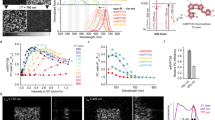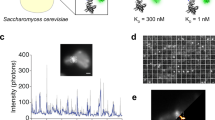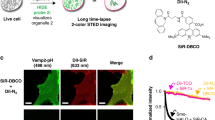Abstract
IrisFP is a photoactivatable fluorescent protein that combines irreversible photoconversion from a green- to a red-emitting form with reversible photoswitching between a fluorescent and a nonfluorescent state in both forms. Here we introduce a monomeric variant, mIrisFP, and demonstrate how its multiple photoactivation modes can be used for pulse-chase experiments combined with subdiffraction-resolution imaging in living cells by using dual-color photoactivation localization microscopy (PALM).
This is a preview of subscription content, access via your institution
Access options
Subscribe to this journal
Receive 12 print issues and online access
$259.00 per year
only $21.58 per issue
Buy this article
- Purchase on Springer Link
- Instant access to full article PDF
Prices may be subject to local taxes which are calculated during checkout



Similar content being viewed by others
References
Adam, V. et al. Proc. Natl. Acad. Sci. USA 105, 18343–18348 (2008).
Betzig, E. et al. Science 313, 1642–1645 (2006).
Hess, S.T., Girirajan, T.P. & Mason, M.D Biophys. J. 91, 4258–4272 (2006).
Bates, M., Huang, B., Dempsey, G.T. & Zhuang, X . Science 317, 1749–1753 (2007).
Hell, S.W Nat. Methods 6, 24–32 (2009).
Hedde, P.N., Fuchs, J., Oswald, F., Wiedenmann, J. & Nienhaus, G.U. Nat. Methods 6, 689–690 (2009).
Lippincott-Schwartz, J. & Patterson, G.H. Trends Cell Biol. 19, 555–565 (2009).
Shaner, N.C., Patterson, G.H. & Davidson, M.W. J. Cell Sci. 120, 4247–4260 (2007).
Wiedenmann, J. & Nienhaus, G.U. Expert Rev. Proteomics 3, 361–374 (2006).
Wiedenmann, J. et al. Proc. Natl. Acad. Sci. USA 101, 15905–15910 (2004).
Shaner, N.C. et al. Nat. Biotechnol. 22, 1567–1572 (2004).
Riedl, J. et al. Nat. Methods 5, 605–607 (2008).
Choi, C.K. et al. Nat. Cell Biol. 10, 1039–1050 (2008).
Webb, D.J., Parsons, J.T. & Horwitz, A.F. Nat. Cell Biol. 4, E97–E100 (2002).
Shroff, H., Galbraith, C.G., Galbraith, J.A. & Betzig, E. Nat. Methods 5, 417–423 (2008).
Wiedenmann, J., Oswald, F. & Nienhaus, G.U. IUBMB Life 61, 1029–1042 (2009).
Karasawa, S., Araki, T., Yamamoto-Hino, M. & Miyawaki, A. J. Biol. Chem. 278, 34167–34171 (2003).
Campbell, R.E. et al. Proc. Natl. Acad. Sci. USA 99, 7877–7882 (2002).
Oswald, F. et al. EMBO J. 21, 5417–5426 (2002).
Kredel, S. et al. Chem. Biol. 15, 224–233 (2008).
Kredel, S. et al. PLoS One 4, e4391 (2009).
Oswald, F., Liptay, S., Adler, G. & Schmid, R.M. Mol. Cell. Biol. 18, 2077–2088 (1998).
Wahl, C., Liptay, S., Adler, G. & Schmid, R.M. J. Clin. Invest. 101, 1163–1174 (1998).
Azoitei, N., Wirth, T. & Baumann, B. J. Neurochem. 93, 1487–1501 (2005).
Acknowledgements
We thank F. Schmitt for his help with generating the A69V variant of EosFP. The expression vector pmRuby–α-actinin was provided by M.W. Davidson (Florida State University). This work was supported by the Deutsche Forschungsgemeinschaft and the State of Baden-Württemberg through the Center for Functional Nanostructures, by Deutsche Forschungsgemeinschaft grant NI 291/9, Landesstiftung Baden-Württemberg and Fonds der Chemischen Industrie.
Author information
Authors and Affiliations
Contributions
G.U.N. supervised the project in conception and discussion. S.B. and M.K. generated mIrisFP. S.B. carried out biophysical characterization of mIrisFP. F.O. produced fusion constructs, transfected HeLa cells and performed widefield microscopy. J.W. supplied materials. J.F. and P.N.H. collected and analyzed PALM images. S.B., J.F., F.O. and G.U.N. wrote the manuscript.
Corresponding author
Ethics declarations
Competing interests
The authors declare no competing financial interests.
Supplementary information
Supplementary Text and Figures
Supplementary Figures 1–15 and Supplementary Tables 1–3 (PDF 2585 kb)
Supplementary Video 1
Paxillin-mIrisFP migration in a live HeLa cell. A time sequence of PALM images shows protein migration after pulse labeling. (MOV 971 kb)
Rights and permissions
About this article
Cite this article
Fuchs, J., Böhme, S., Oswald, F. et al. A photoactivatable marker protein for pulse-chase imaging with superresolution. Nat Methods 7, 627–630 (2010). https://doi.org/10.1038/nmeth.1477
Received:
Accepted:
Published:
Issue Date:
DOI: https://doi.org/10.1038/nmeth.1477
This article is cited by
-
Switchable stimulated Raman scattering microscopy with photochromic vibrational probes
Nature Communications (2021)
-
High-speed super-resolution imaging of rotationally symmetric structures using SPEED microscopy and 2D-to-3D transformation
Nature Protocols (2021)
-
Trophic upgrading of long-chain polyunsaturated fatty acids by polychaetes: a stable isotope approach using Alitta virens
Marine Biology (2021)
-
Correlative cryo super-resolution light and electron microscopy on mammalian cells using fluorescent proteins
Scientific Reports (2019)
-
Cytoplasmic Transport Machinery of the SPF27 Homologue Num1 in Ustilago maydis
Scientific Reports (2018)



